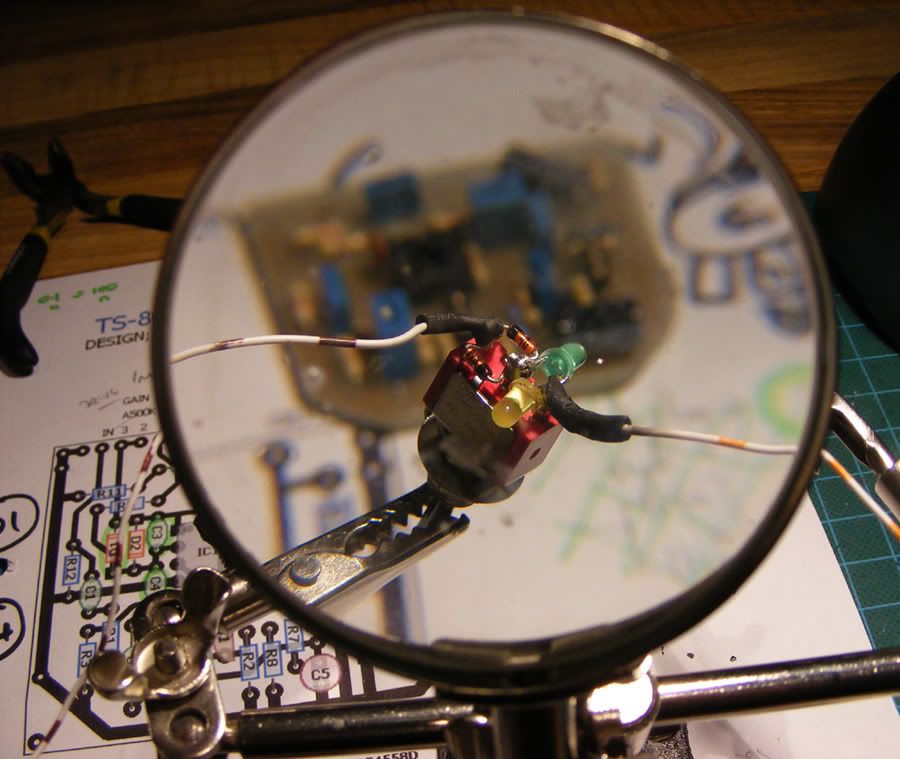|
|
Post by flateric on Apr 19, 2010 15:03:04 GMT -5
I have become obsessed with modding tubescreamer pedals for bass and guitar, this is the little clipping switch I've developed for my Sonic Kitchen Tubes Creamer.  A bit fiddly to solder but a neat little unit that can solder directly onto any overdrive pcb to replace the 2 parallel clipping diodes in the circuit. This is an ON/OFF/ON switch so when its in on position 1 it shorts out the 2 Si diodes and routes signal thru the LED diodes. In On position 2 it does the reverse. On the middle OFF position it routes signal thru both sets which knocks the output way down. The LED distortion is much higher volume raw gain, biting aggressive distortion, you can go from raw crunch to a splatty fuzz. the Si diodes gives you the conventional Tubescreamer overdrive, much softer sweeter harmonics and lower output that you can compensate for with the volume knob. Using the same switch and 2 different capacitors instead of the diode pairs, soldered direct to teh switch lugs, you get the great AMZ Phat mod which for me is essential for using the pedal effectively with the bass guitar. The jumper wires then replace the 0.047uF input cap. On ecap choice remains at 0.047uF for the characteristic tubescreamer mid tone boost, the other can go up to 0.47 or 0.68uF to let a huge load of bass through which, to be honest, sounds fabulous! |
|
|
|
Post by ijustwannastrat on Apr 19, 2010 16:06:12 GMT -5
Wait. Did I understand correctly that you are sending the sound through the LEDs?
|
|
|
|
Post by flateric on Apr 19, 2010 16:38:38 GMT -5
oh yes. They don't light up of course, but they are used in their capacity as rather leaky clipping diodes. You can use a huge variety of different diode things mixed and matched, paired or not to give different quality of clipping overdrive. Did you have a look at my sonic kitchen ultimate Tubecreamer post?
|
|
|
|
Post by sydsbluesky on Apr 19, 2010 17:45:59 GMT -5
After what amount of trial and result (no such thing as error!) did you come to LEDs for this? EDIT: Yeah, strat.. it seems a bit odd, but it may help to consider that LED stands for Light Emitting Diode, after all... I'll leave further explainations to someone that knows a bit about this. (clearly not me...  ) |
|
|
|
Post by flateric on Apr 20, 2010 1:39:32 GMT -5
Heh! It's well documented in internet articles and effects box/electronics sites, I can't take credit for this. A lot of the distortion stompbox kits you can buy also have LED's as the clipping diodes as standard. They produce such a totally different tone and feel to Si or Ge diodes that being able to switch between different ones in this manner gives you 2 overdrive pedals in one, though both of course using the same op amp circuit.
Adding the bass mod then gives me a really versatile unit which is great for either bass guitar or lead. So thats 4 pedals in one, sort of.
|
|
|
|
Post by thetragichero on Sept 17, 2010 15:31:11 GMT -5
are any additional resistors needed for the LEDs (as you would need to light them up) compared to the Si and Ge diodes ?
i've got a Tweak-O boost kit from small bear electronics and i think i wanna be able to switch between different diodes
|
|
|
|
Post by ashcatlt on Sept 17, 2010 17:22:49 GMT -5
Nope. The Si and/or germ diodes have the same issue, so any necessary current limiting will already be there. As long as the LEDs drop in exactly where the others are (electronically speaking, not necessarily physically) you'll be fine.
|
|
|
|
Post by thetragichero on Sept 20, 2010 15:37:48 GMT -5
i might be making it up, but i thought i read that using 3 diodes (2 in one direction, one in the other) produces a more desirable sound... can you confirm/deny this?
|
|
|
|
Post by ashcatlt on Sept 20, 2010 16:39:43 GMT -5
Two diodes in series add their diode drops together, so it takes twice the voltage before it clips. Doing that on one side of the waveform causes it to be clipped harder on the other side. The output wave is asymmetrical. That's supposed to give more even order harmonics which is said to sound more like tubes.
Is that desirable to you?
|
|
|
|
Post by thetragichero on Sept 20, 2010 19:22:06 GMT -5
yes please!
|
|
|
|
Post by ashcatlt on Sept 21, 2010 1:06:51 GMT -5
A resistor in series with one of the diodes has a similar effect. And a variable resistor... Read this. |
|